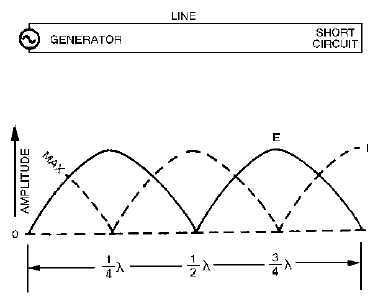3-37
The voltage at the center and the ends varies at a sinusoidal rate between the limits shown. At the
one-fourth the three-fourths points, the voltage is always zero. A continuous series of diagrams such as
these is difficult to see with conventional test equipment, which reads the effective or average voltage
over several cycles. The curve of amplitude over the length of line for several cycles is shown in figure
3-29, view B. A meter will read zero at the points shown and will show a maximum voltage at the center,
no matter how many cycles pass.
As shown in view D, the amplitude varies along the length of the line. In this case it is zero at the
end and center but maximum at the one-fourth and three-fourths points. The entire diagram of the open-
ended line conditions is shown in view E. The standing waves of voltage and current appear together.
Observe that one is maximum when the other is minimum. The current and voltage standing waves are
one-quarter cycle, or 90 degrees, out of phase with one another.
REFLECTION OF AC VOLTAGE FROM A SHORT CIRCUIT
Reflection is complete when an rf line is terminated in a short circuit, but the effect on voltage and
current differs from the effect obtained in an open-ended line. Voltage is reflected in opposite phase,
while current is reflected in phase. Again look at the series of diagrams in figure 3-27. The left column
represents current, and the right column shows voltage changes on the shorted line. The standard
representation of standing waves on a shorted line is shown in figure 3-30; the voltage is a solid line, and
WKH FXUUHQW LV D GDVKHG OLQH 7KH YROWDJH LV ]HUR DW WKH HQG DQG FHQWHU DQG PD[LPXP DW WKH DQG
SRLQWV ZKLOH WKH FXUUHQW LV PD[LPXP DW WKH HQG DQG FHQWHU DQG PLQLPXP DW WKH DQG SRLQWV
Figure 3-30.—Standing waves on a shorted line.
As we discussed voltage and current waves on transmission lines, we pointed out several differences
between open and shorted lines. Basic differences also appear in the standing-wave patterns for open and
shorted lines. You can see these differences by comparing figure 3-29, view E, and figure 3-30. Notice
that the current and voltage standing waves are shifted 90 degrees with respect to the termination. At the
open end of a line, voltage is maximum (zero if there are no losses in the line). At a short circuit, current
is maximum and voltage is minimum.
Q23. Two types of waves are formed on a transmission line. What names are given to these waves?

